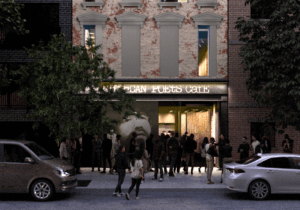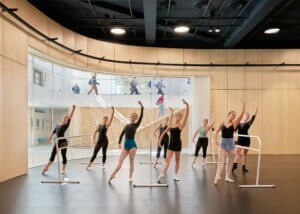On a humid, gray morning at Princeton in a cubic glass pavilion in a robot arm–equipped garage, architect Mario Gooden sat on a stool silently while discordant sounds emanated from two televisions flanking him that played images, barely visible under the sun streaming in through the translucent walls. Us viewers sat on the benches wrapping the room. Gooden moved his stool and sat again. Finally, he began speaking. Reading from a black folder he talked about space-time, general relativity, and black holes, and about the Black Panthers, being age 13, being American, cinema’s star-crossed lovers, the “image-city,” being in the wake, or being the wake.
So began the second day of Black Imagination Matters (BIM, so named to “scramble” the usual meaning of the acronym in architecture), a two day conference organized by V. Mitch McEwen, which was the culmination of a month of workshops this past March and April which included prototyping fictive technologies from W.E.B. Du Bois’s recently-discovered short story “The Princess Steel” as well as choreography workshops with drones. This past weekend’s events showcased numerous architects, theorists, writers, and artists thinking about “architechnipoetics,” or the intersections between the ways we make our world in bricks and circuits and words and movement.
“You’re composing images with your body,” Gooden incanted over syncopated, and at times, dissonant sounds. Eventually he fell back to silence, though the soundtrack continued. At the end of Gooden’s silence, McEwen asked for our own. The sky cleared.
Then, a slightly more usual panel with Jenn Nkiru, beth coleman, and Jerome Haferd. coleman began by asking one of the most difficult questions of all: “What would it be to be free?”
Many others joined in during the conversation. In response to discourse on the spiritual and celestial, author Sharifa Rhodes-Pitts, who presented later and then spoke in a panel alongside artist Mario Moore, offered that the many ways of telling and documenting time in various African traditions is something that, to some extent, can be known, and that the archive of such traditions, no matter how troubled, perhaps offers some grounding.
The BIM Incubator was incredibly capacious for an event organized by an architecture school, bringing together poets, dancers, filmmakers, scholars, technologists, architects, and others who presented and celebrated inter- and antidisciplinary approaches to thinking about space, building, the future of the city, and the power of Blackness within it. Collaborative and open, BIM was modeled on Donna Haraway’s use of the notion of “sympoiesis,” a process of collective making and knowledge production.
Science fictions and science presents were blended throughout the event’s discussions, most especially by Haferd, whose presentation on his projects in Harlem’s Marcus Garvey Park began with Ursula K. Le Guin; Samuel R. Delany, Octavia Butler, and Sun Ra all got namedropped throughout the day.
Saturday’s events took place between Princeton’s Architecture Laboratory and the robot-outfitted Embodied Computation Lab. Rhythm; the water; terrestrial freedom; celestial freedom; the archive; the body; time; telling time; telling times; (im)permanence; the traps and powers, the uses and uselessness of representation; visibility and its transgression (what is secrecy and sacredness in an era of mass surveillance and documentation?, probed Nkiru); the meaning of “practice”; the problem of authenticity— these all were themes that were returned to throughout the day. The convening of so many people itself was a sort of architectural act, making a space through a day of ongoing interactions of speech, sound, images, and movement.
And there was so much movement, especially for a university workshop, not only in Gooden’s multimedia performance but also in poet Douglas Kearney’s listening workshop during which he permitted participants to be as still or move as much as they felt to the music and sound he had created. Amina Blacksher next presented her double Dutch robots, two robot coordinated robot arms, that with the help of a human being, became semi-automated jump ropes. After Blacksher went first, people took turns trying to show off their skills. Despite their supposed “precision,” the robots have difficulty being as accurate, synchronized, and quick as young Black girls who jump rope, showing the incredible complexity of embodied and kinetic intelligence that is so often devalued and overlooked. Also working with robots, Lauren Vasey demonstrated the early stages of robots that used facial recognition to behave differently based on people’s features, raising questions about the built-in algorithmic biases in new AI technologies. Then came an especially energetic three-person dance piece choreographed by Olivier Tarpaga titled WHEN BIRDS REFUSED TO FLY. All this motion suggested that perhaps architecture doesn’t stand, but rather, and more accurately, buildings balance.
The day ended with sunset as Kyp Malone played his guitar and sang, accompanied by projections he’d designed.











